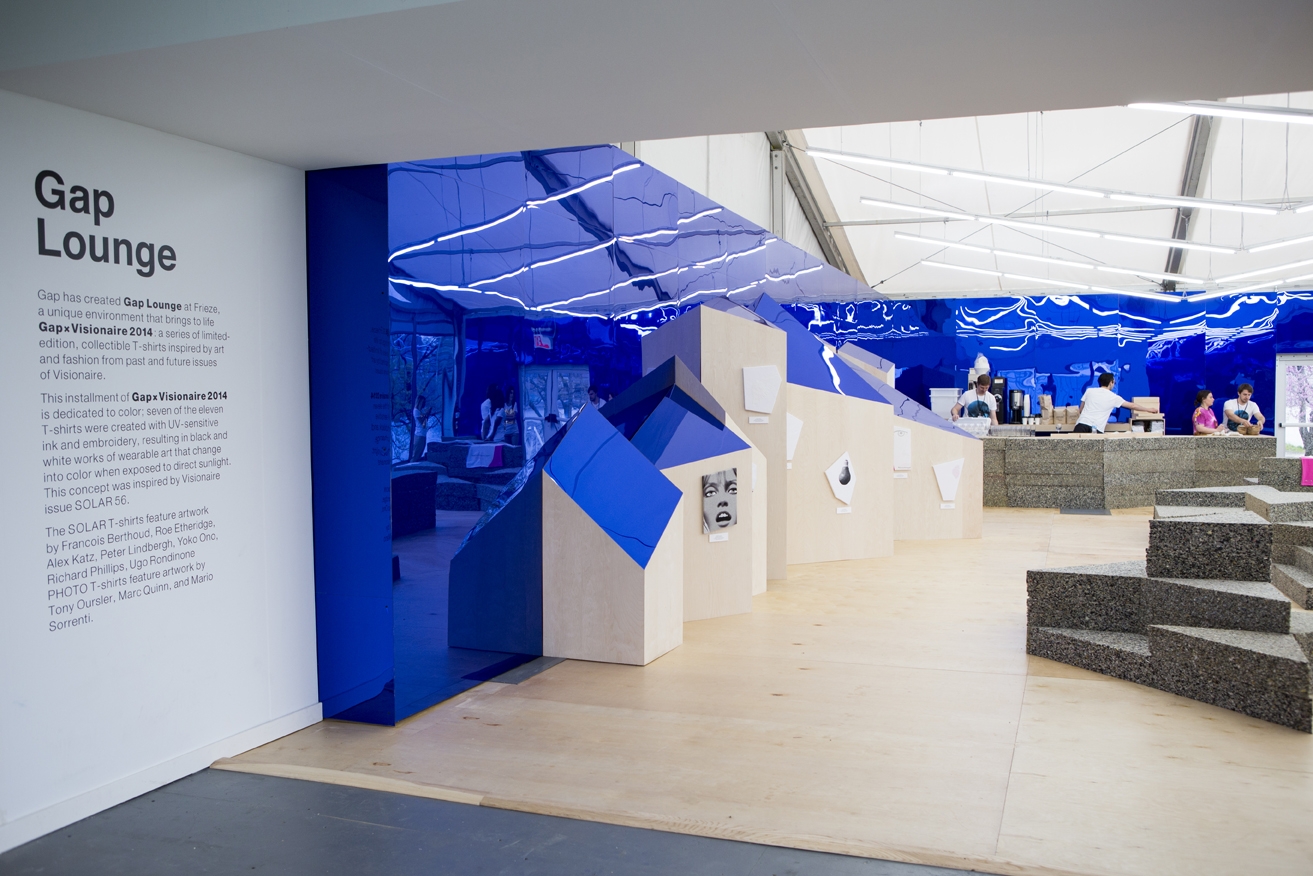Don’t overthink this: when I say Frieze Art Fair, what comes to mind? Islands you never knew existed in the East River? Fresh, yummy Neapolitan pizza? Flutes of champagne? Some art around? A lot of scary people? Frieze Projects’ smiling curator Cecilia Alemani getting rowed around in a small boat by artist Marie Lorenz? (Please don’t die Cecilia, we need more happy people) Surely, you don’t think of sad, suburban malls and Annie’s Pretzels—which is why it seemed like a joke when it was announced Frieze was partnering with, of all horrible, soul-killing corporate mega-brands, Gap, to present a Gap Lounge in Frieze New York and Frieze London. Gap was a thing in the 1990s, when I used to work there in high school, in a really depressing mall outside Atlanta. This was when basic casual wear was in, Gap’s commercials were cool, and the Gap Card gave you an additional 15% off all of their Bangladeshi-made attire!
Since then, though, the coolest thing Gap has done has been its unwitting involvement in Art Club 2000, those clever Cooper Union kids re-popular of late who donned Gap attire, posing around New York City from 1992-1999, like tongue-in-cheek members of a Hardt and Negri street gang; they were ciphers of late-stage capitalism, of which Gap was perfectly representative, when youth culture was commodity par excellence and New York City its neoliberal locust. But seriously, outside of desperate measures, who goes to Gap now when there’s Uniqlo or American Apparel, who offer sizing for all of us on the whiskey-and-kale New York City diet?
For its ‘nontraditional retail space’ at the fair, Gap partnered with Visionaire (you should be embarrassed, cool magazine) to present eleven T-shirts designed by artists ranging from Ugo Rondinone to Yoko Ono, many of which were printed with UV-sensitive ink; expose Rondinone’s T-shirt to the sun, and a cast of blue light appears beneath the hanging lightbulb depicted on it. Go outside (yes, it exists!) and a halo of blue sky appears around Ono’s floating white cloud, along with the word ‘dream’. If I were to follow its aspirational message, I would Cut Piece the fuck out of it, it’s so ugly. Better is her white T-shirt covered in a square of gold foil, Grow Love with Me, which is a reworking of the original silver foil on black. Other t-shirts feature ‘allover’ prints by Mario Sorrenti and Tony Oursler, among others – the former depicts a polar landscape, the latter, a big eye looking through a keyhole.
These were all draped rather lazily on weird, spongy, triangular building blocks forming both seating and structure for the apparel. They were clustered in the centre of the space, opposite a shiny, reflective blue wall marked by jagged outcrops of wood that propped up stretched shirts. The space looked something like an airport lounge, except a tad bit cooler and with very good coffee, which was free. Since I was broke and couldn’t afford a $34.95 t-shirt, I had a few cups before grilling the salespeople as to whether they were Gap employees or Frieze employees. Turns out they’re ‘other’, which suggests there’s some international shadow organisation tasked to refresh outdated brands by inserting them into legitimate art fairs, such that no one benefits; the fair looks stupid and the brand desperate – the upside for me being I had a convenient excuse to ignore Frieze itself. I had a job to do, and it was to linger in Gap’s Third Space, far from relevance.
The trick, however, was that I had to walk through the fair to exit, which means I was actually forced to see some stuff. Allyson Vieira presented a labyrinth of metal wall studs for her presentation with Laurel Gitlen, Carroll Dunham showed a bunch of fabulously lewd drawings at Barbara Gladstone, but what was really cool was Marianne Goodman’s ‘booth’, which she did away with entirely, hanging simply a mobile by Danh Vo, Massive Black Hole in the Dark Heart of Our Milky Way. It was a bunch of brittle cardboard pieces embellished with gold-leaf American flags and Coca-Cola logos, a portrait of American patriotism gone awry. As a whole, the fair seemed a little more experimental this year – as experimental as an art fair can be. If I wished, I could’ve even stayed there, in Allen Ruppersberg’s restaged hotel from 1971, which featured two rooms priced at $350 a night, including dinner and breakfast. But it would be the least-relaxing setting on Earth, situated, as it is, in such a high-stakes commercial setting. Maybe Ruppersberg offered a bottle of prescription pills as well; you’d need a few Xanax just to get through the night.
16 May 2014
